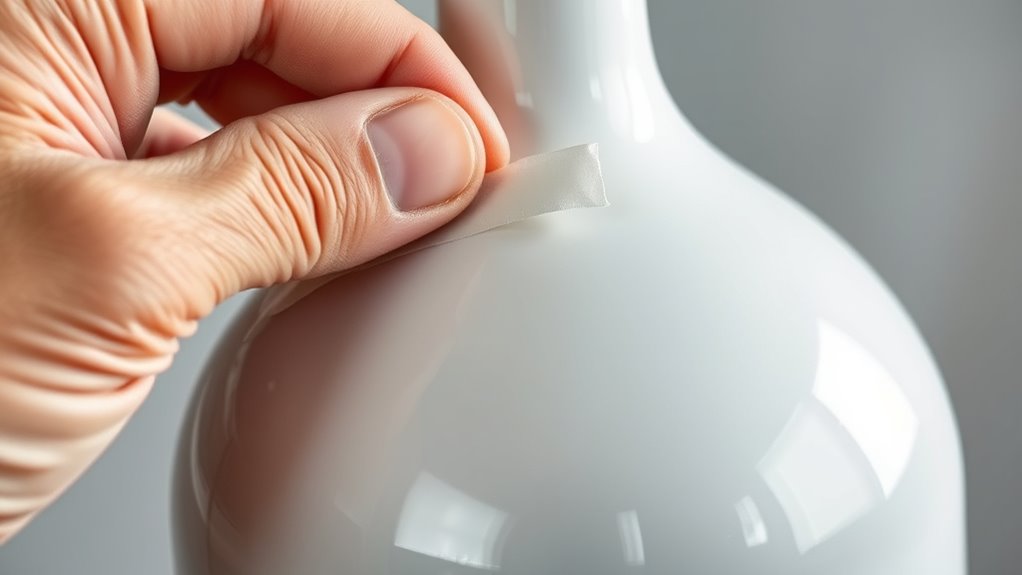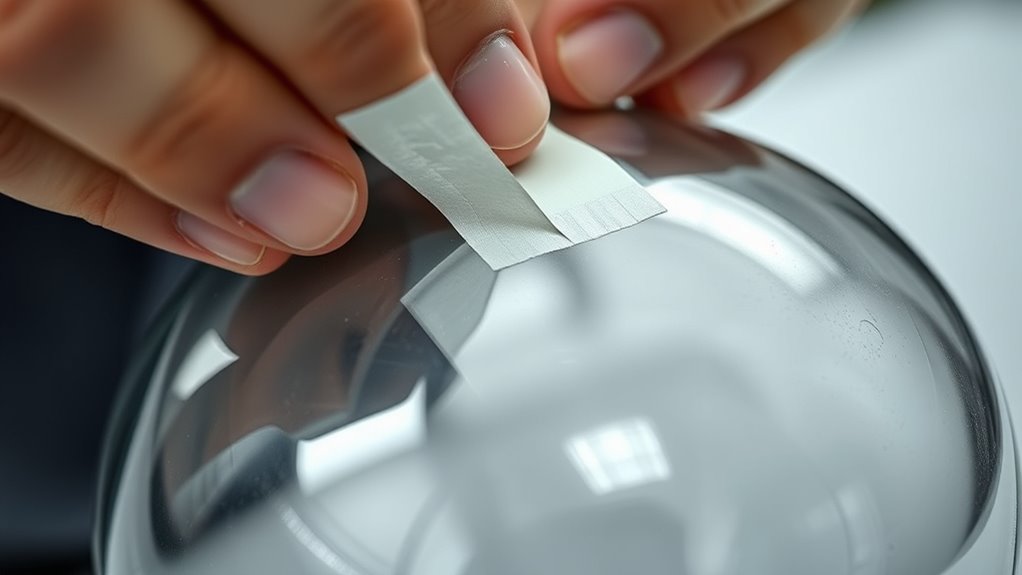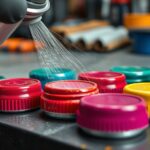To mask and tape curves on round bottles, start by thoroughly cleaning the surface to guarantee good adhesion. Choose flexible painter’s tapes designed for curves and sensitive surfaces. Carefully press the tape along the contours, smoothing out bubbles with your fingers or a rounded tool for a perfect fit. Remove the tape slowly at a sharp angle to prevent damage. Mastering these steps helps you achieve professional, clean lines—keep going to discover more tips for flawless masking.
Key Takeaways
- Thoroughly clean the bottle surface to ensure optimal tape adhesion and prevent paint bleeding.
- Use flexible painter’s tapes designed for curved surfaces, selecting low to medium adhesion types.
- Carefully press and smooth tape along curves with fingers or rounded tools to conform to contours.
- Apply small tabs or flaps to mold tape around difficult areas for better coverage and precision.
- Remove tape slowly at a sharp angle, ensuring clean lines and preventing damage to the painted surface.

Masking and taping curves on round bottles can be challenging, but with the right techniques, you can achieve clean, professional results. The first step is surface preparation. Before you start masking, make sure the bottle’s surface is thoroughly cleaned and free of dust, oils, or residues. Use a gentle solvent or alcohol wipe to ensure the surface is spotless. Proper surface prep ensures that the tape adheres well and that paint or other coatings won’t peel or bleed underneath. Take your time to clean every curve and contour, especially in hard-to-reach areas, as this step lays the foundation for a smooth masking process.
Once the surface is prepared, focus on adhesive selection. Not all tapes are created equal, and choosing the right adhesive can make or break your project. For round bottles, flexible painter’s tapes or specialty curves tapes tend to work best because they conform better to curved surfaces. Look for tapes with low to medium adhesion—this allows for good sticking without damaging the surface or leaving sticky residue when removed. If you’re working with delicate or painted surfaces, opt for painter’s tapes designed for sensitive surfaces to avoid lifting paint when you peel the tape off. The right adhesive selection ensures that the tape stays in place during painting but also comes off cleanly afterward, preserving the quality of your finish.
When applying the tape, press it down carefully along the curves, making sure to smooth out any bubbles or wrinkles. This minimizes paint bleed and helps maintain clean lines. For tight curves and complex shapes, consider using a flexible or painter’s tape that can stretch slightly, conforming to the bottle’s contours. Use a rounded tool or your finger to press the tape into the curves, ensuring maximum contact. If needed, cut small tabs or flaps to help mold the tape around difficult areas, then press them down firmly. During removal, do so slowly and at a sharp angle to prevent peeling or damaging your paint job. Additionally, understanding the importance of WWE Raw’s Financial Impact can be useful if you decide to monetize or promote your craft business, as it highlights the significance of strategic investments and audience engagement.
Frequently Asked Questions
What Types of Tape Are Best for Curved Surfaces?
For curved surfaces like round bottles, you should choose tape with high adhesive strength and excellent tape flexibility. Painter’s tape or automotive masking tape work well because they conform to curves without lifting or tearing. These tapes provide a secure hold while allowing you to easily remove them without leaving residue. Their flexibility ensures smooth application around curves, and their adhesive strength keeps the tape in place during your project.
How Do I Prevent Tape From Peeling During Application?
To prevent tape from peeling during application, you need to make certain the adhesive strength matches your project’s needs. Clean the surface thoroughly before taping, as dirt reduces adhesion. Use tape with high durability designed for curved surfaces, and press firmly as you apply to create a strong bond. Avoid overstretching the tape, which can weaken its adhesion. These steps help secure the tape and prevent peeling during your project.
Can Masking Damage the Bottle’s Finish?
You might find masking damaging the bottle’s finish if you rush or use harsh tapes. Proper masking techniques, like choosing gentle tapes and avoiding excessive pressure, help preserve the finish. The coincidence is that careful preparation and patience safeguard both your work and the bottle’s integrity. By taking your time, you ensure your finish remains pristine, and masking becomes a tool for precision rather than damage.
How Do I Remove Tape Without Leaving Residue?
To remove tape without leaving residue, gently peel it back at a 45-degree angle, pulling slowly to minimize residue. If any sticky residue remains, use a soft cloth dampened with alcohol or a commercial residue remover for effective residue removal. Consider tape alternatives like painter’s tape or low-tack masking tape, which are designed to come off easily without leaving residue or damaging the finish.
What Tools Are Recommended for Precise Masking on Curves?
For precise masking on curves, use flexible masking tape or painter’s tape designed for delicate surfaces. Employ masking techniques like curve wrapping, where you gently mold the tape along the bottle’s contours for a snug fit. Use a small, soft tool like a plastic spatula or your fingertip to press the tape smoothly into the curves, preventing paint bleed and ensuring clean edges. This approach gives you sharp, professional results on rounded surfaces.
Conclusion
So, when you’re working on masking and taping those tricky curves, remember it’s all about patience and a gentle touch. Take your time and follow the contours carefully, like giving your bottles a little hug. With a bit of practice and a steady hand, you’ll find it’s easier than it seems, and soon enough, your designs will look smooth and flawless. Just enjoy the process, and your bottles will thank you with that perfect finish.
















